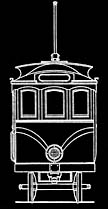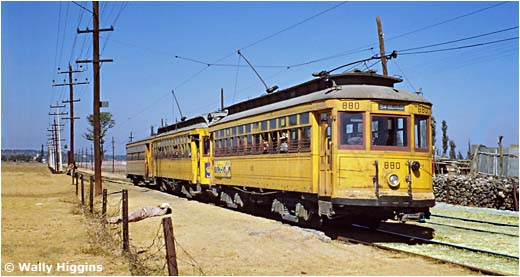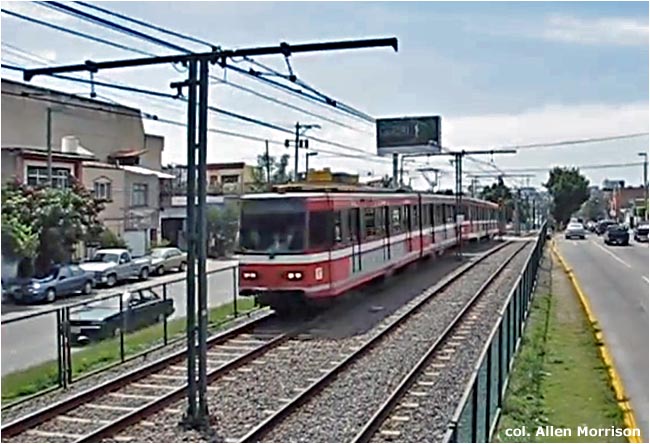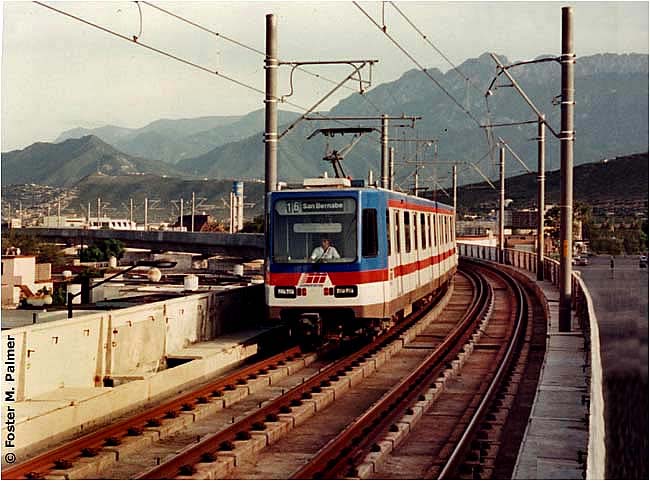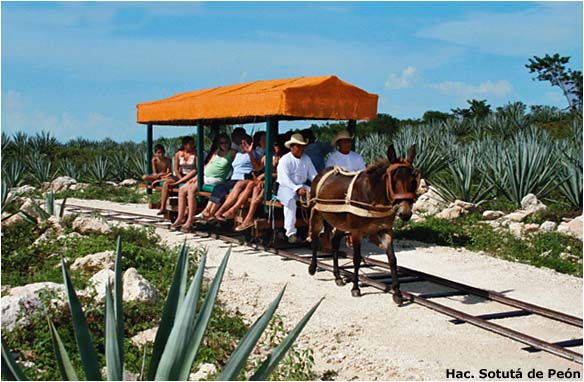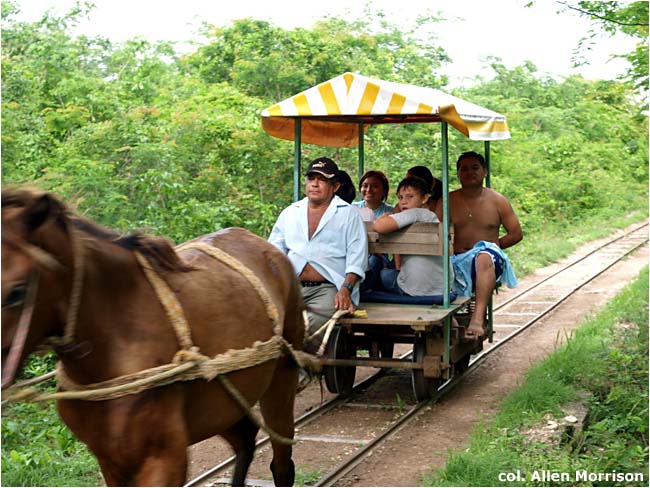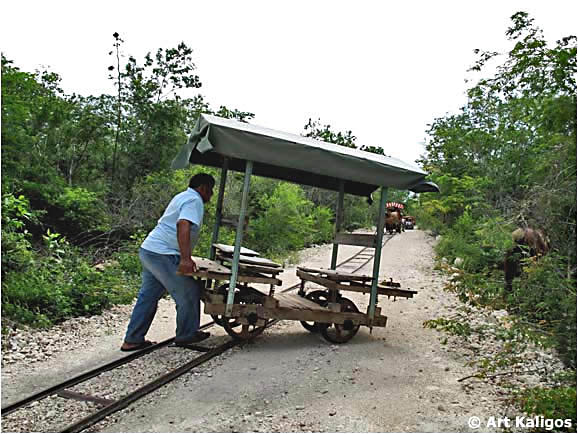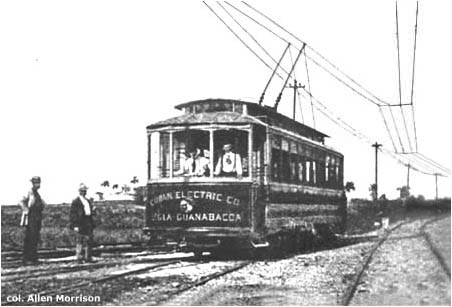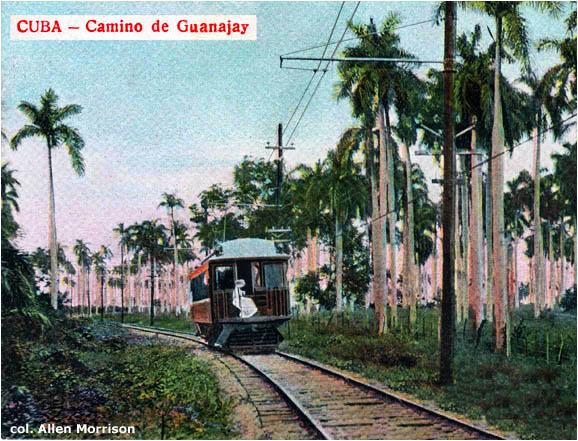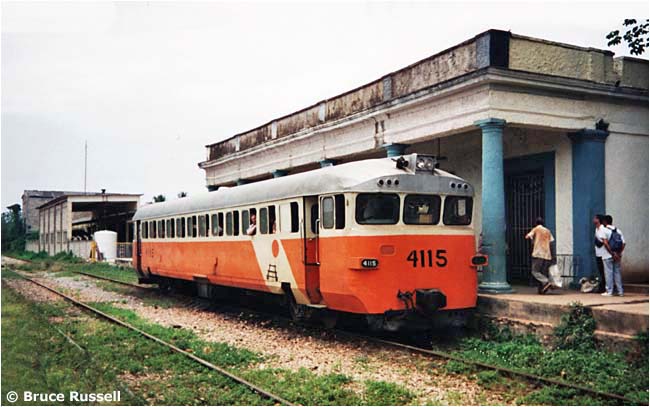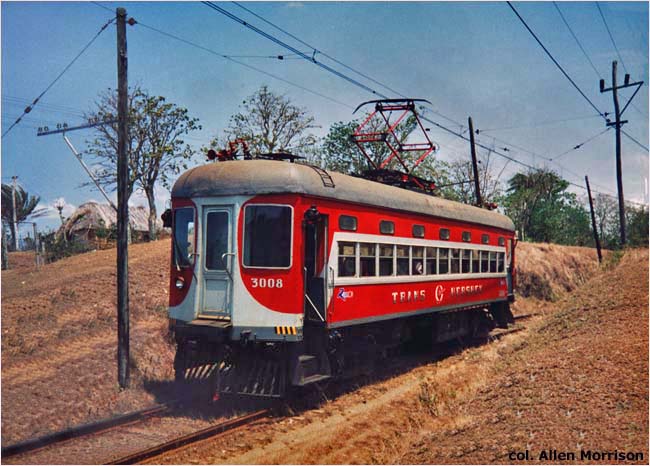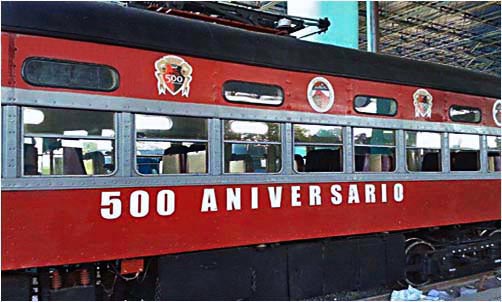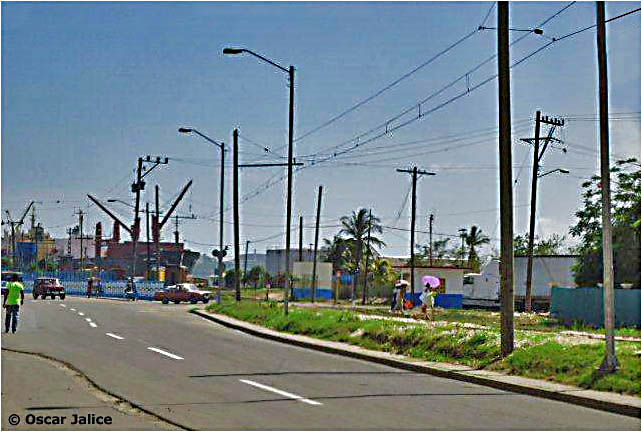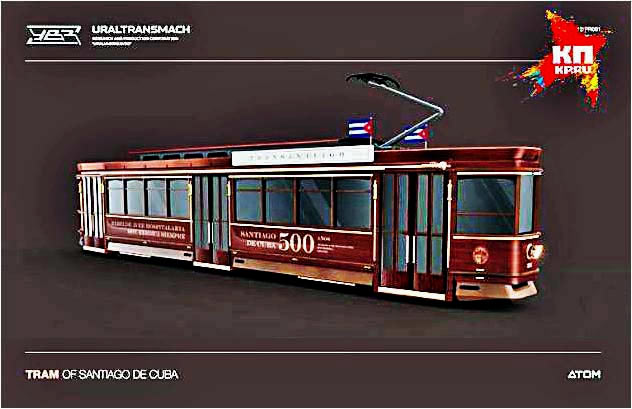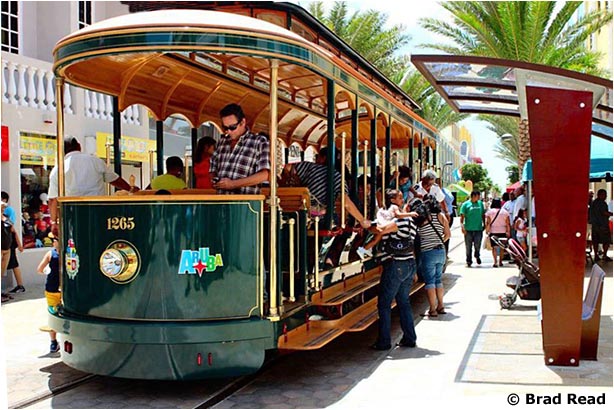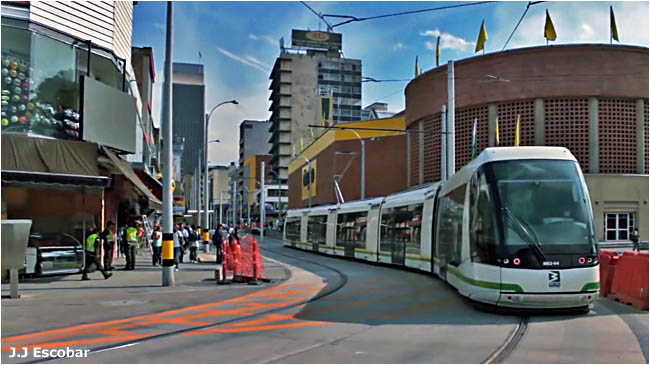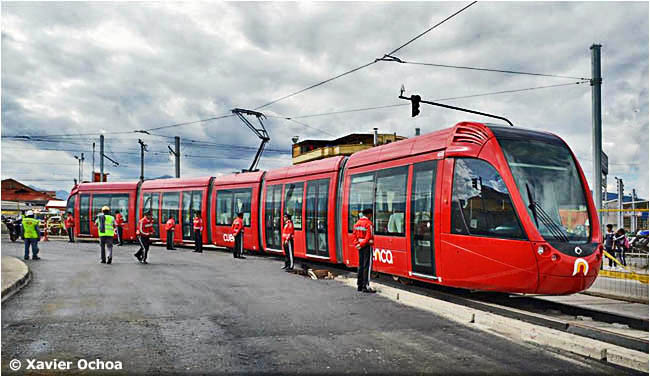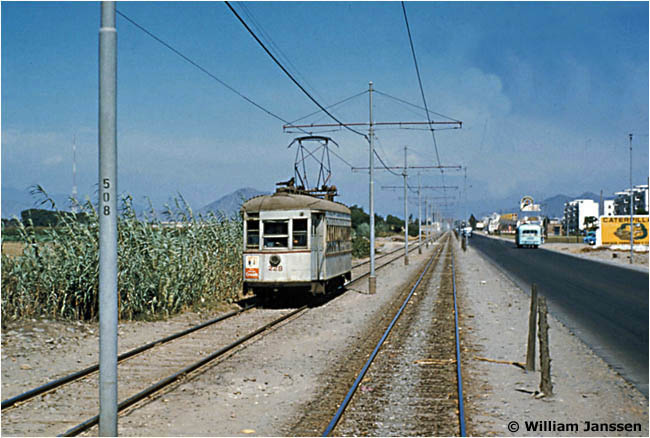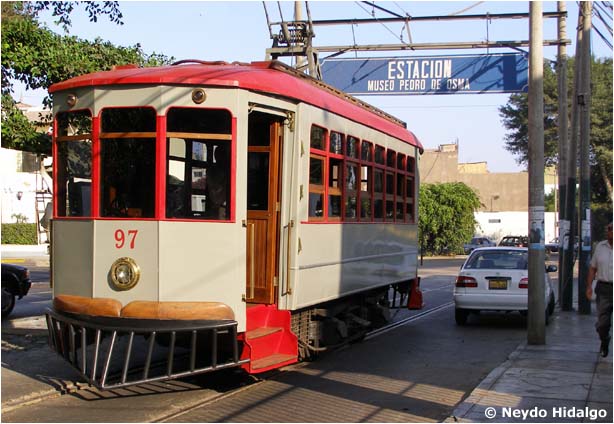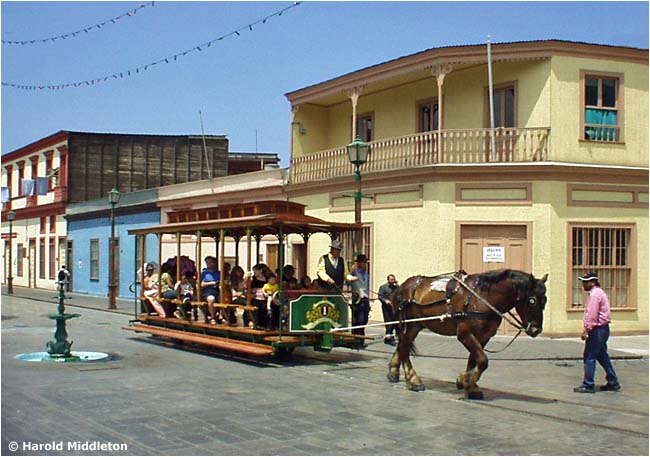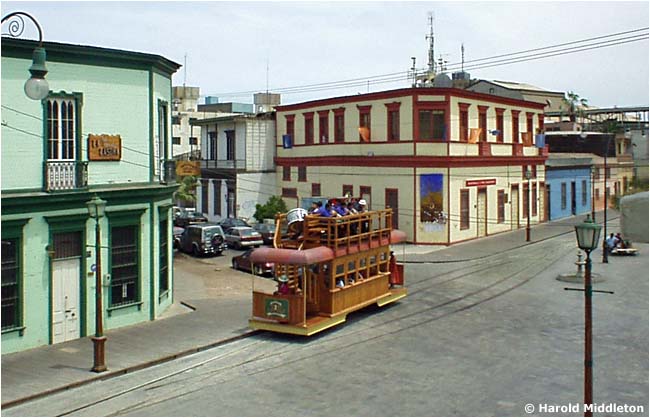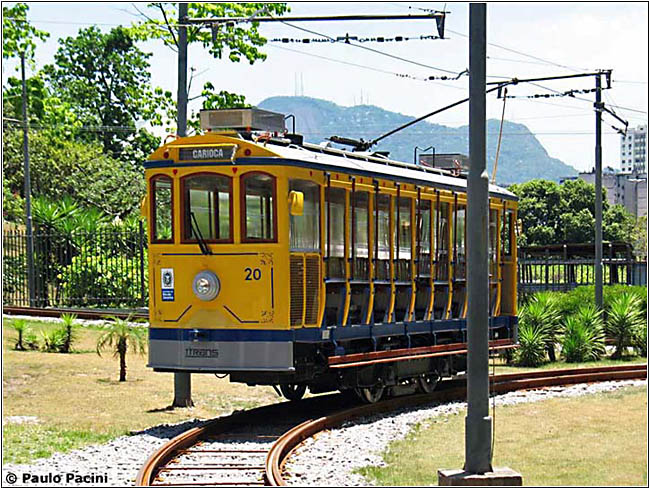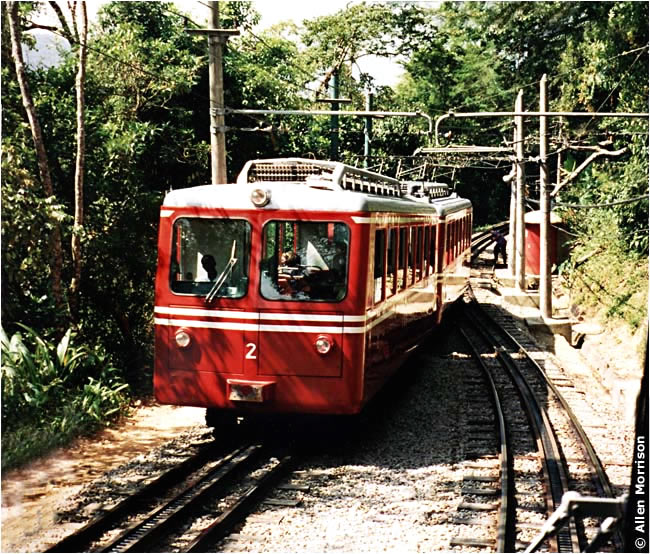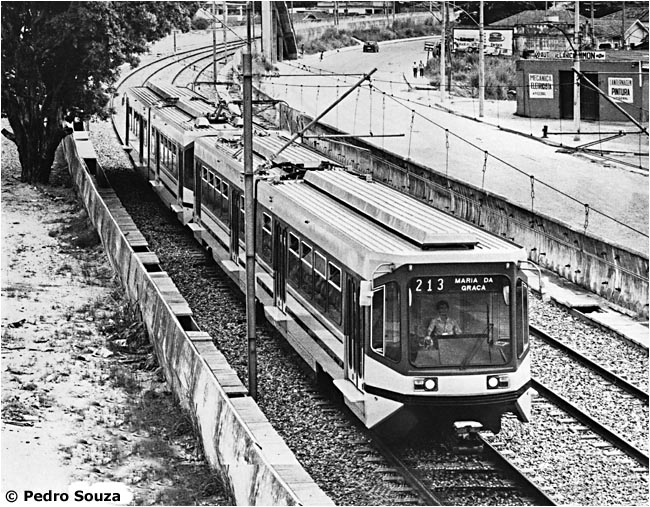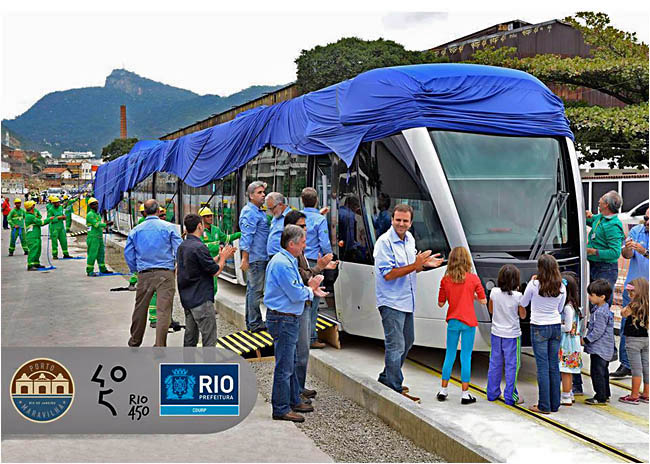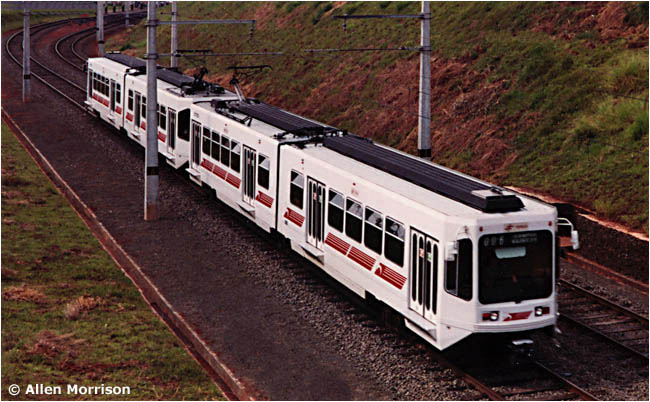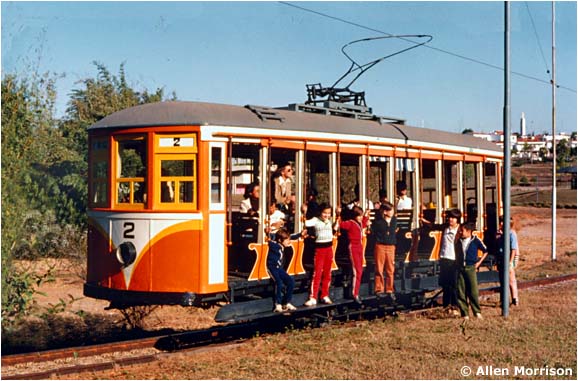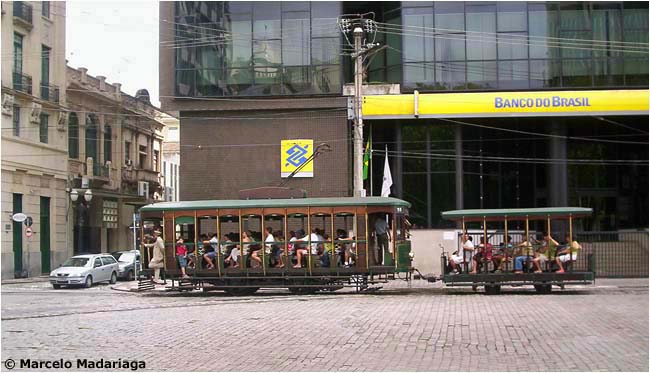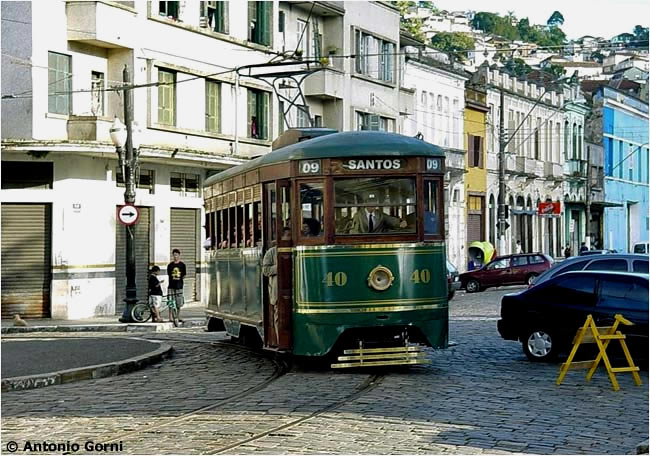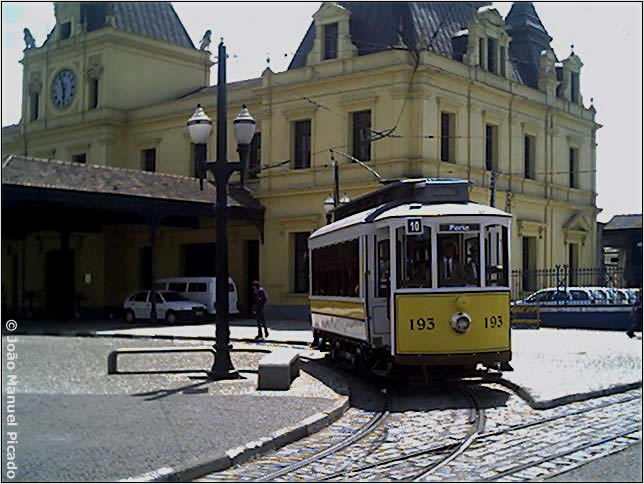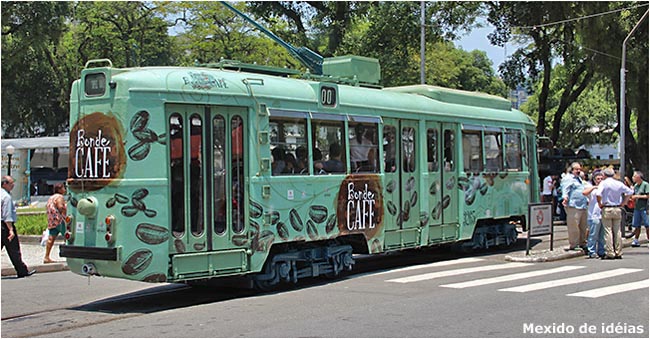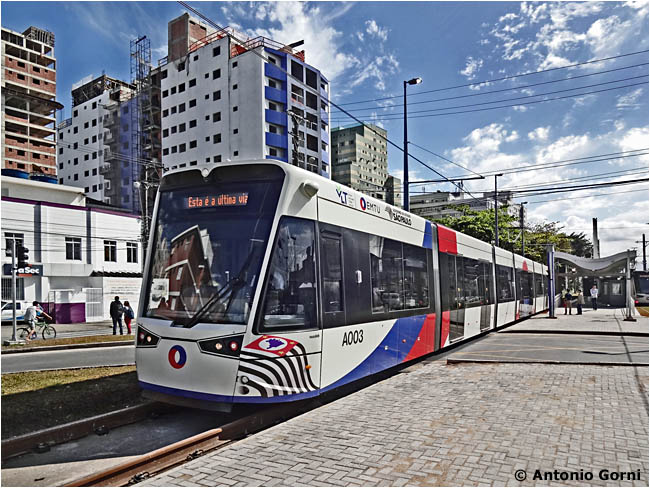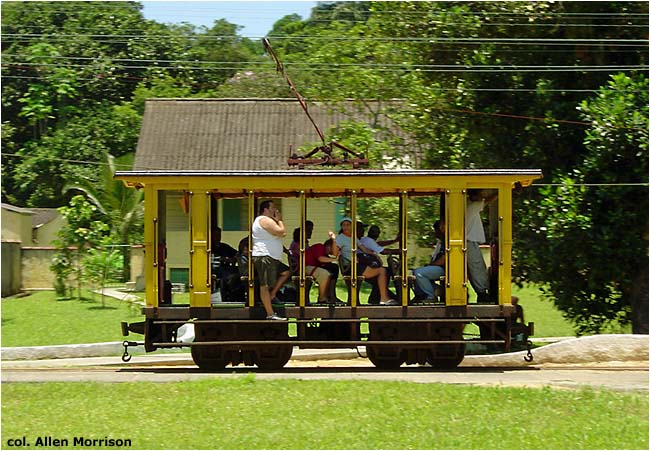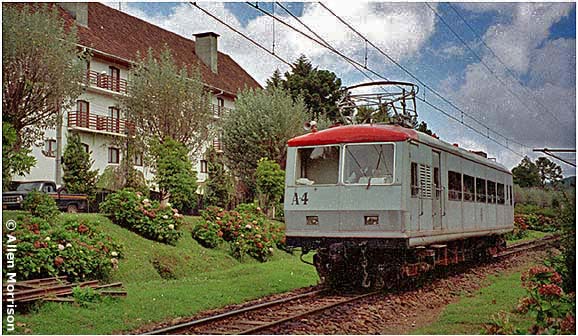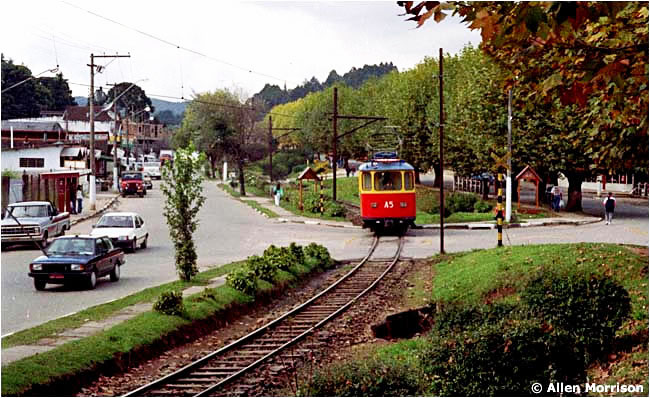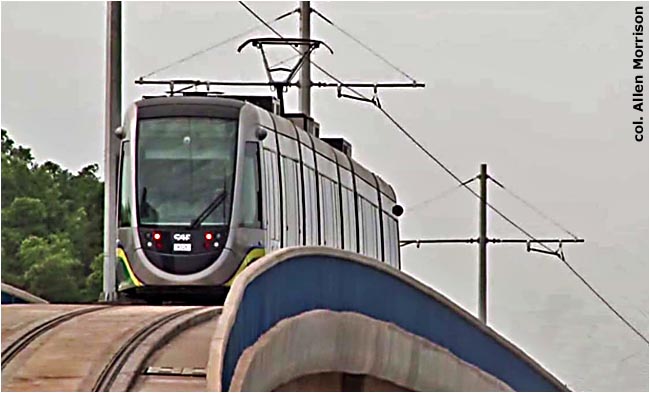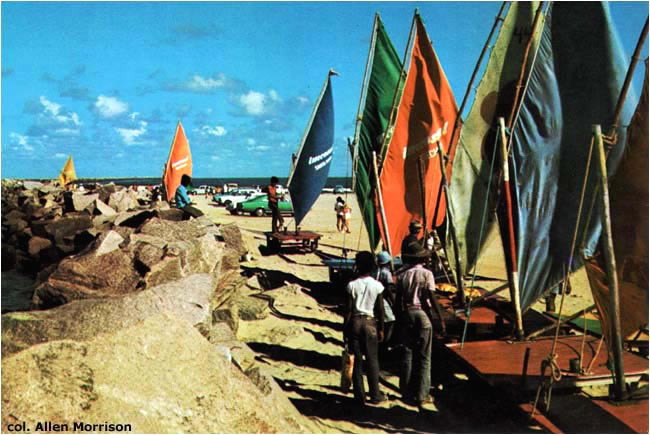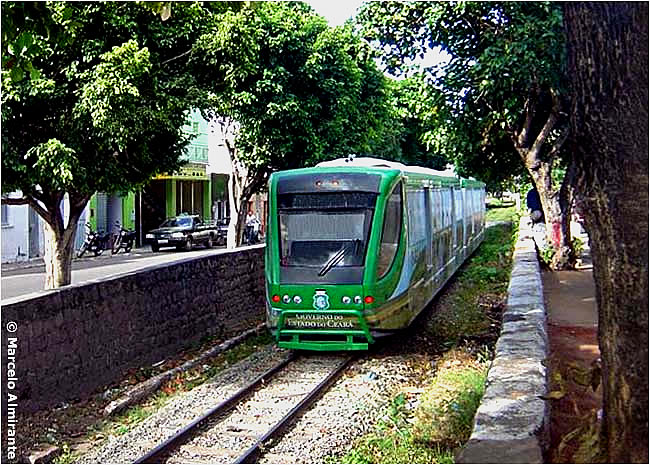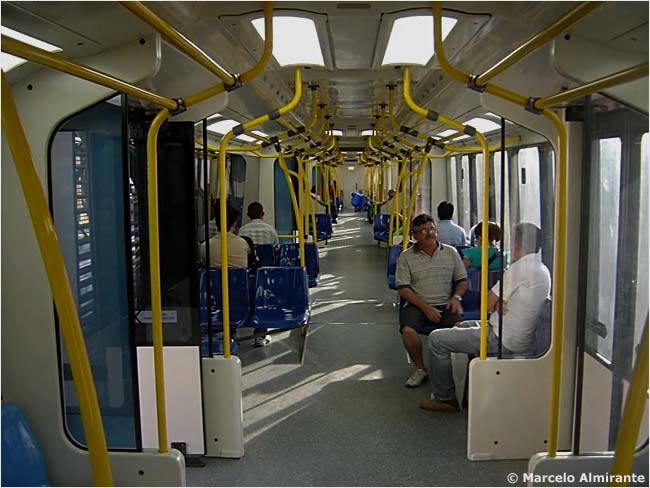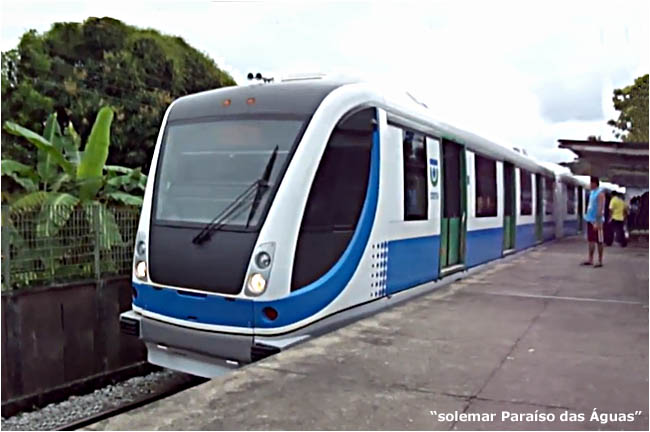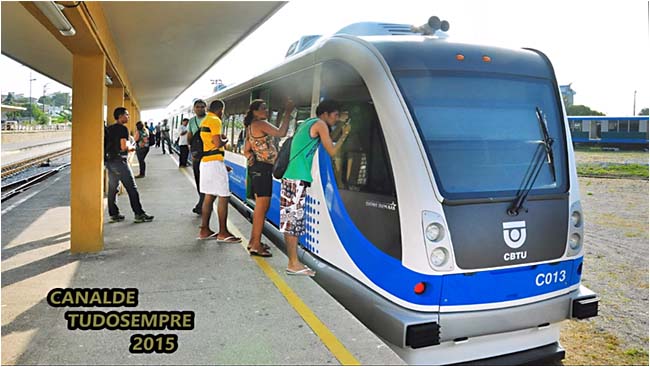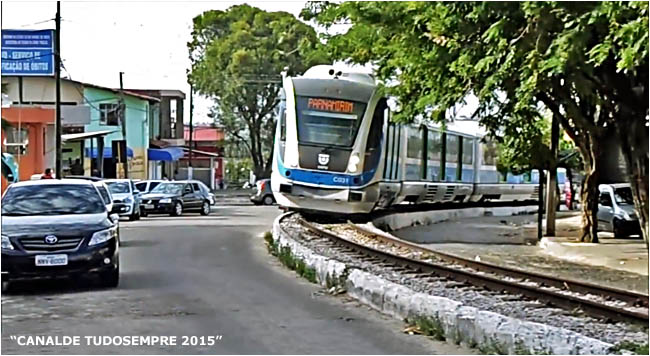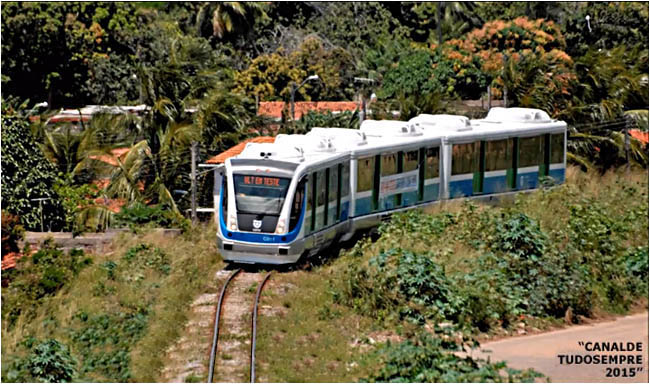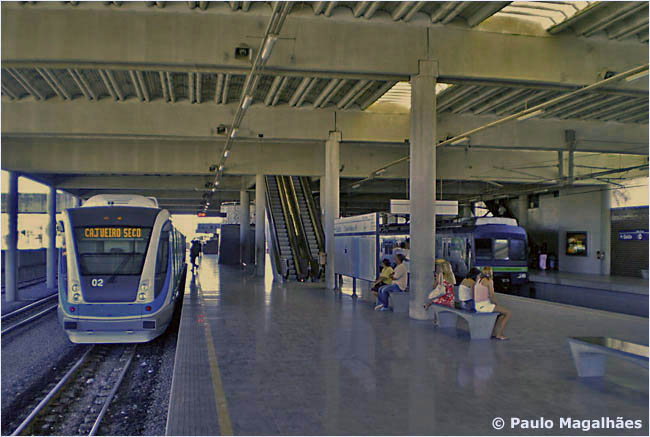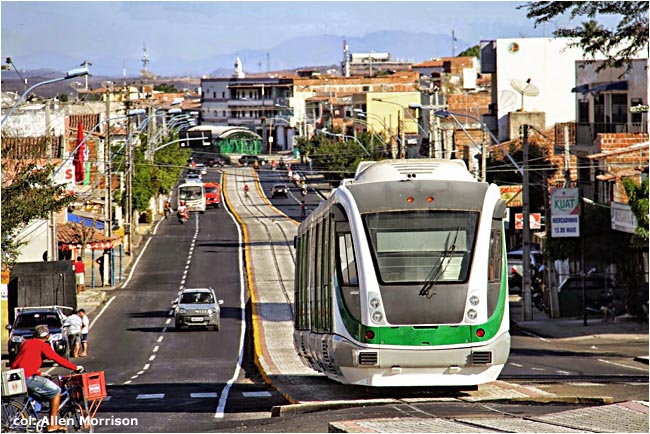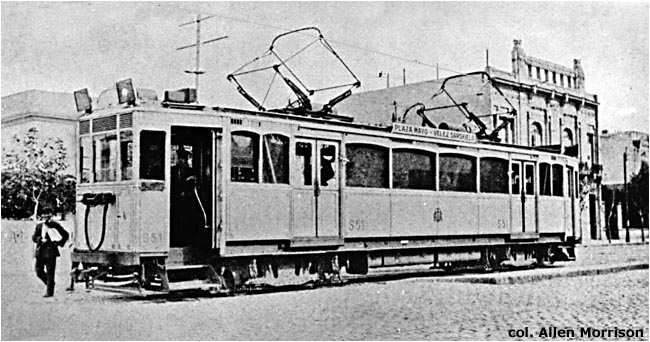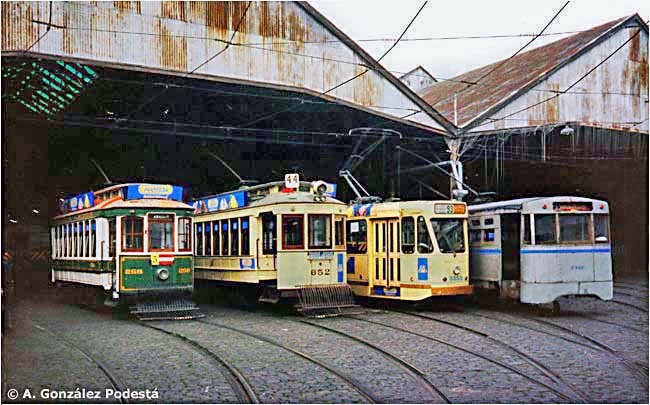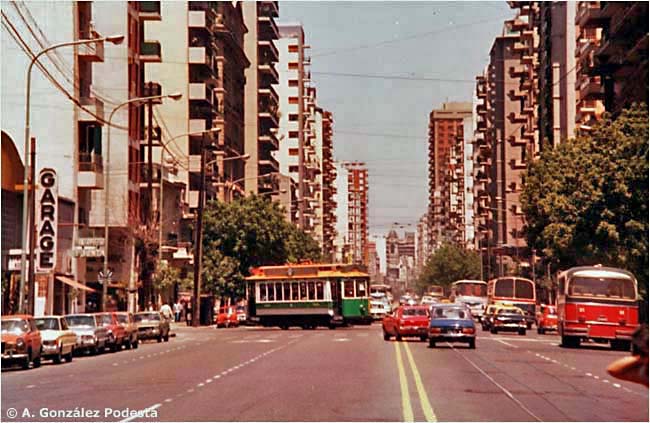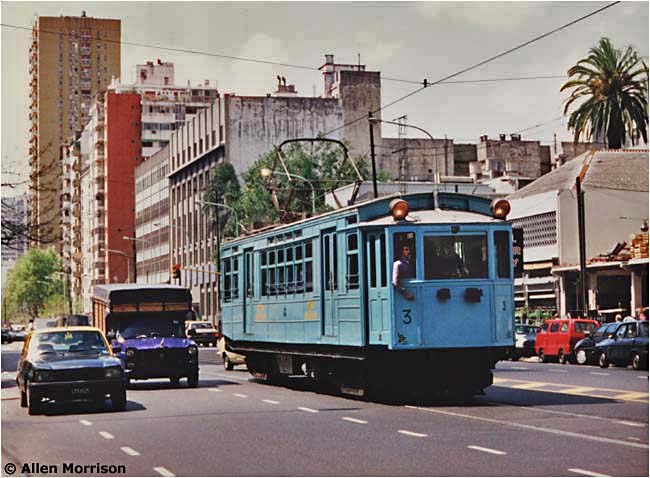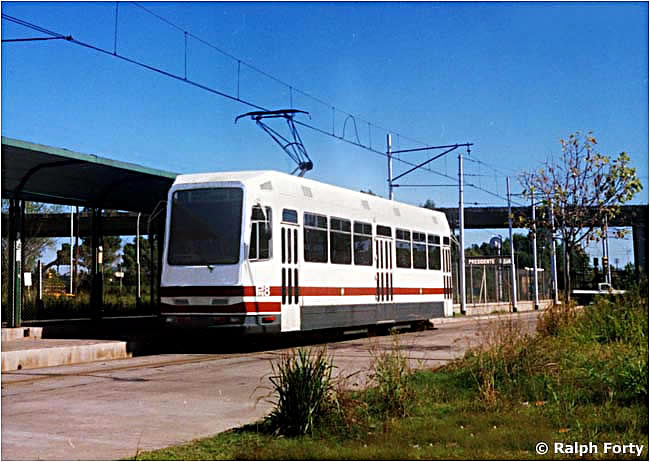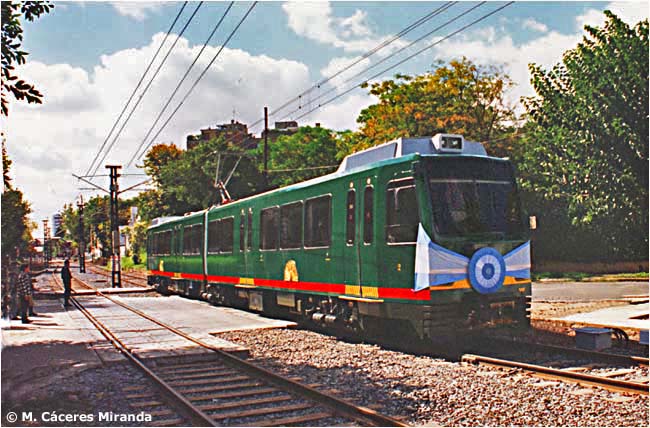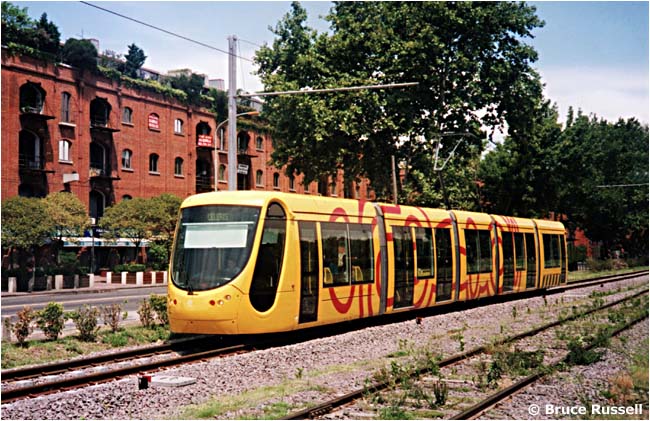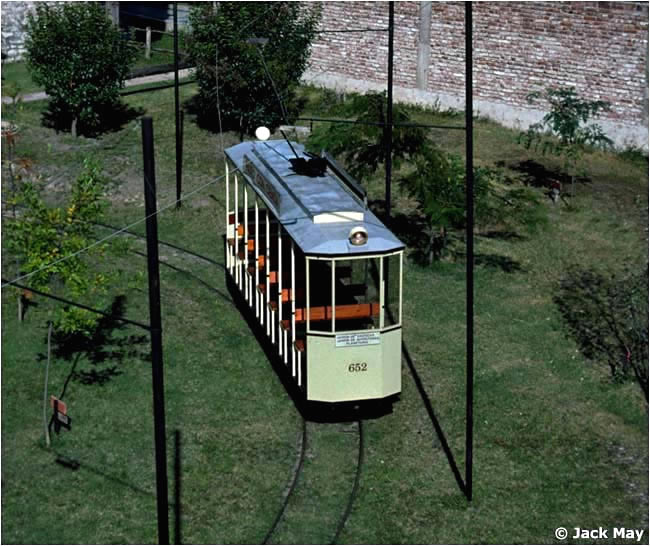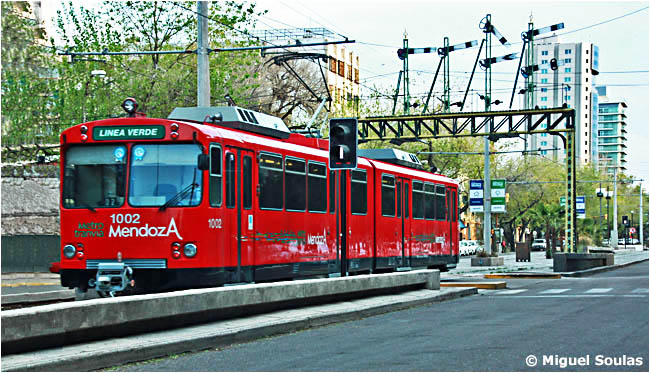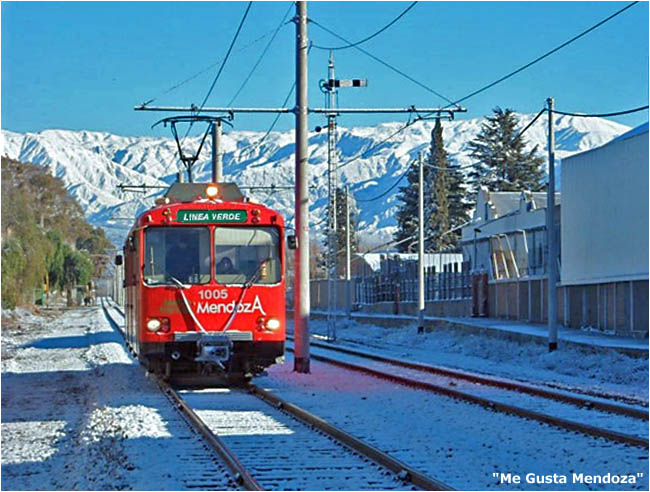THE TRAMWAYS OF
LATIN AMERICA
in 2017
Allen Morrison
AN ILLUSTRATED SURVEY OF WHAT'S RUNNING TODAY During the last 150 years about 700 tramway systems operated in the 30 countries located south of the United States. Thanks largely to U.S. entrepreneurs, Mexico City, Havana, Santiago de Chile and Rio de Janeiro all had commercial street railway operations by 1859, before most cities in Europe. Tramway development exploded in the 1870s. Brazil experimented with battery trams in the 1880s and opened Latin America's first real electric line in 1892. Cuba and Mexico inaugurated their first interurban electric lines in 1900 and Chile built its first electric rack railway in 1902. Argentina introduced a "subway-service" tram in 1914 that might be considered the continent's first "light rail" vehicle. In 1931 Peru built trams out of trolleybuses! Uruguay opened one of the world's first heritage tram lines in 1967. About two dozen tramways operate in nine countries today. Horsetrams still carry passengers on the Yucatán peninsula. The Santa Teresa tramway in Rio de Janeiro, inaugurated in 1896, is the oldest electric line in Latin America and one of the oldest anywhere. A line that Mexico City built in 1910 still functions. The rack tramway that Rio de Janeiro electrified in 1910 is now the only electric rack line in the hemisphere. The heritage tramway in Campinas is almost a half century old. Since the 1980s new tramways have opened in twelve cities and new systems are under construction in a half dozen others. Here are brief descriptions, maps and pictures of these lines, along with brief historical data, arranged approximately from north to south.
MEXICO
|
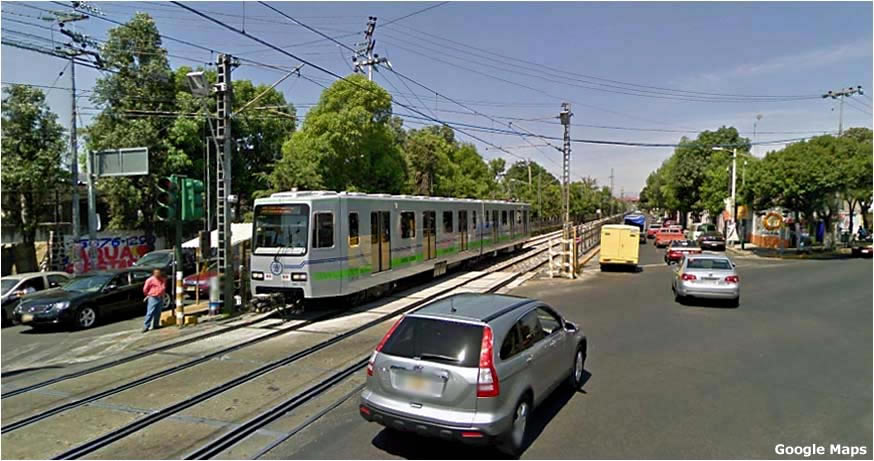
The
20 vehicles that run on Mexico City's "Tren Ligero" were all built by
Concarril S.A. at its plant in Ciudad Sahagún, 50 km northeast
of the capital; Concarril was acquired by Bombardier Transportation in
1992. Concarril/Bombardier also built 48 similar units for the Sistema
de Tren Eléctrico Urbano in Guadalajara, Mexico's second city,
which ran its first "Tren Eléctrico" in 1989. The photograph
below shows a Guadalajara train in 2010 [Pavel Kurdna, courtesy Jiri
Kroupa]:
The Guadalajara system is much larger than the operation in Mexico City. Line 1 crosses the city from north to south and uses a former trolleybus tunnel in the center [see map]. There are numerous grade crossings protected by gates. East-west line 2 runs completely underground. Line 3 under construction will run diagonally across the city in tunnel and on viaducts. Concarril/Bombardier also built 62 two-car trains of the same type for Metrorrey, the rapid transit system in Monterrey, Mexico's third city, which inaugurated its first line in 1991. Another 22 units came from Construcciones y Auxiliar de Ferrocarriles (CAF) in Spain. The 31 km Monterrey system has two lines that are completely grade-separated, above or below ground [see map]. The photograph below was taken in August 1991 [Foster M. Palmer]:
Yucatán haciendas • Chuncanán The Yucatán peninsula was the center of Mexico's henequen industry during the late 19th and early 20th centuries. Hundreds of haciendas dotted the flat, rocky terrain and elaborate networks of horsedrawn railways were built around the plantations, and from the plantations to nearby railroad stations and ports. Some of the lines became common carriers and transported passengers as well as sisal hemp. Track gauge was usually 500 mm and track length approached 4,500 km [see map]. Many of the haciendas closed during the Depression and the railways were abandoned. But many of the rails remained and it is still possible today to ride improvised tramcars – oddly called trucks in Yucatán – on these Decauville tracks in several locations near Mérida: Hacienda Katanchel near Tixkokob, 24 km east of Mérida; Hacienda Dzoyaxché in the Cuxtal Ecological Reserve 30 km south of Mérida; Hacienda San Pedro Ochil, 38 km southwest; and Hacienda Sotuta de Peón nearby. Here is a scene at the latter hacienda, where the rails seem to have been freshly relaid:
Trams also still run on a remnant of a 23 km interurban line built in 1907 between the steam railroad station in Acanceh and Hacienda Chunkanán near Cuzamá, 50 km southeast of Mérida [see map]. After the plantation was destroyed by Hurricane Isidore in 2002, local residents maintained the railway since it passed three cenotes (underground rivers) which they thought had tourist appeal. The railway was the only way to reach them, so the tracks were repaired and a fleet of plantation trucks was restored, roofed and repainted. The Chunkanán tramway began transporting passengers over 9 km of the line, from the hacienda to the cenotes, in 2005 [see map]. The photograph below was taken in 2009 [col. AM]: Riding the trucks to see, photograph and swim in the Chunkanán cenotes has become a tremendous success. The three cenotes, named Chelentun, Chansinic'che and Bolonchoojol, are spaced about 3 km apart and the line is single track [see map]. When two trucks meet, the driver of the inbound truck lifts his vehicle off the rails so that the outbound truck can pass. In this view the passengers and horse have stepped to one side [Art Kaligos]:
With the popularity of the trucks at Chunkanán, tramway operation may be restored at other places. Early data for Yucatán railways, including the hacienda lines, can be found in the 1893-1907 editions of the Anuario Estadístico published by Mexico's Secretaría de Fomento, Colonización e Industria. There are also interesting descriptions of Yucatán tramways on pp. 501-507 of A Handbook of Mexico published by Great Britain's Naval Staff, Intelligence Department, in 1919; see excerpt. My 5-part website on The Tramways of Yucatán surveys development in the 20th century. Try "chunkanán truck" or "cuzamá cenotes" or similar word combinations in Google and YouTube. (Note: there is another place named Chunkanán in Campeche state.)
_____________
CUBA The island of Cuba lies only 175 km from the Yucatán peninsula. Cuba had Latin America's first steam railroad in 1837, one of its first street railways in 1858, and one of its first interurban electric lines in 1900. In March of that year Cuban Electric Co. opened a 7-km tramway between Guanabacoa and Regla, a port on Havana Bay across from Havana [see map] [Electrical World & Engineer (New York), 2 June 1900]:
Havana Electric Railway opened its urban streetcar system (which also used twin trolley poles) in 1901. Another company, Havana Central Railroad, built a 50 km interurban line to Guanajay (which used only one pole) in 1906 [see map]. This was a completely new rail line, not an electrification of an existing steam-powered railroad [postcard, col. AM]:
Havana Central opened a second electric line to Güines in 1907 [see map] and was acquired by United Railways of Havana, which electrified several steam lines in the area. A fifth company, Western Railway of Havana, built an electric line to Rincón in 1914; battery trams served the extension to San Antonio. All these single-pole electric lines were de-electrified around 1940, but diesel railcars continue to run over the same rails today to Güines and San Antonio. This photograph was taken at San Antonio station in 1998 [Bruce Russell]:
Tram-like diesel vehicles also run on other railroads in Cuba and on secondary rail lines in other countries in Latin America. Hershey Chocolate Corporation built an elaborate railway network in Cuba in the 1910s to bring sugar cane from the fields and workers from nearby towns to its central (refinery) 50 km east of Havana [see map]. The system was electrified in 1922 and was absorbed by Ferrocarriles de Cuba in 1960. After Cuba's last urban tramway quit in 1954, the Hershey railway became the only electric line on the island. The photograph below shows one of the original cars delivered by J. G. Brill in 1920, reconditioned and labeled "TRANS HERSHEY" for tourist service [col. AM]:
Electric operation continues today from Casa Blanca, across the bay from Havana, to Matanzas, a distance of 90 km, and along several branches [see map]. In 1998 Ferrocarriles de Cuba acquired eight electric cars second-hand from Ferrocarrils de la Generalitat de Catalunya in Barcelona, Spain, which now provide the bulk of service. The Hershey sugar mill closed in 2002, but the railway struggles on. See my page on The Hershey Cuban Railway. Two 4-minute videos depict journeys on "El Tren de Casa Blanca a Hershey": (1) from Casa Blanca to Hershey, and (2) from Hershey to Casa Blanca. In 2015, as part of the celebration of the 500th anniversary of its founding in 1515, the city of Santiago de Cuba at the east end of the island wanted to operate a tourist tramway service over disused railway tracks along the harbor. None of the vehicles from its original tram system that closed in 1952 had been saved, so it acquired "TRANS HERSHEY" car 3008 from the Hershey line and brought it to Santiago. The photograph below shows 3008 at the railway shops with new inscriptions and decorations [col. AM]:
_____________
The "ABC islands" of the Kingdom of the Netherlands lie about 30 km (18 mi) off the coast of Venezuela [see area map]. Both Aruba and Curaçao had small industrial railways from the mid-19th century, but until recently the only passenger-carrying street railway on the islands was in Willemstad on Curaçao. It operated both animal- and gasoline-powered trams between 1887 and 1920. In 2012 Aruban Prime Minister Mike Eman signed an agreement with Richard Branson, founder of the Virgin Group, the Carbon War Room, and other "green" organizations, to make Aruba "the world's first 100% green economy". As part of the program he placed an order with trambuilder TIB/m in California for two battery-powered trams, one single-deck and one double-deck, to run on the 2 km line that he laid on the streets of Oranjestad, the island's principal city [see tramway map]. The vehicles are powered by batteries augmented by hydrogen fuel cells, which in turn are powered by Curaçao's year-round trade winds. The single-deck car arrived on 15 December 2012 and began carrying passengers a week later [Brad Read]:
The double-decker arrived in June 2013. Rides on both cars are enormously popular with tourists that arrive on cruise ships that dock in the harbor. See The Streetcars of Oranjestad.
_____________
In 2013 the Wall Street Journal and the Urban Land Institute chose Medellín as the "Innovative City of the Year". On a list of 200 cities around the world, few had improved as much, they felt, in the preceding two decades. Its homicide rate had dropped 80%. Its government had built new schools, hospitals, libraries, parks and recreation centers at an impressive rate. Metro de Medellín had completed two metro lines and three aerial cableways, colossal in scale, to neighborhoods in the hills (two more are on the way). In 2011 its Universidad Pontificia Bolivariana imported a trolleybus from Belarus and built a 1/2 km trolleybus line around its campus. How many universities do that? Ever eager to outshine Colombia's much larger capital city, Bogotá, which despite its population still has no electric transport at all, Metro de Medellín signed a contract in 2011 with Lohr Industrie of France (acquired by Alstom in 2012) to build a "Translohr" line between San Antonio metro station and the east side of town – a sort of eastward continuation of metro route B [see map]. Alstom sent 12 rubber-tired trains in 2014, tests began in July 2015, and the 4.3 km "Tranvía de Ayacucho" started carrying passengers free of charge the following October. Commercial service is planned for early 2016 [J.J Escobar]:
The city has preserved and restored tram 19 from its original tram system that closed in 1951.
See The Trams and Trolleybuses of Medellín.
_____________ Cuenca is Ecuador's third largest city (after Guayaquil and Quito) and the capital of Azuay province near Ecuador's border with Peru. At altitude 2,550 m/8,366 ft, it is one of the world's highest large cities. Current population is about 400,000. Because of its relatively remote location Cuenca retained much of its colonial architecture and character and its historic center was declared a World Heritage Site by UNESCO in 1999. The city was not reached by railroad or paved highway until the 1960s and never before had a street railway of any kind, That
situation has changed. In 2013 the local municipality signed a contract
with Alstom of France to build a 10.3 km electric tram line between the
city's north and south sides [see map].
Alstom supplied fourteen 5-module 300-passenger Citadis model 302
trams, which will use APS in the city's historic center. Construction
began that year and the first vehicle, number 1001, arrived in July
2015. It ran its first test on the line in October and gave residents
free rides on the city's Independence Day, 3 November 2015. The photo
below shows car 1009 [Xavier Ochoa]:
Full commercial service is planned for September 2016. See The New Tramway in Cuenca, Ecuador.
_____________
The entire Lima tramway system, including the suburban lines to Callao, Barranco and Chorrillos, closed after a strike in 1965. Three decades later, the local electricity company opened an electricity museum on Av. Pedro de Osma in Barranco. In 1996 it rescued a tram from a scrapyard, rebuilt it, and restored the rails and wire along a six-block section of the long-abandoned tram line in front of the museum [see map]. The Vagón del Recuerdo, as it is called – "nostalgia car", began carrying passengers on 22 August 1997 and has been carrying them ever since. Operation is Tuesday-Sunday 10-5. The tram was one of dozens built in the 1920s by Società Ernesto Breda in Milano. (The "97" shown in the photograph marks the year it returned to service; it is not the car's original fleet number, which could not be determined) [Neydo Hidalgo]:
See official webpage of El Tranvía Eléctrico in Barranco. Barranco.net presents two photographs and information. See Part 4 of my pages on The Tramways of Lima. The photographer of this hectic video ran behind the moving vehicle . . .
_____________
This big port in northern Chile had streetcars powered by horses, gasoline motors and electric batteries, but never had a real electric system. All rail transport ended in 1930. In 2000, the city decided to restore a principal thoroughfare, Paseo Baquedano, to its former glory with wood-planked sidewalks on the sides and an old-fashioned tramway in the center. Construction of a meter-gauge line began in 2001 and inauguration finally took place on 24 October 2004 [Harold Middleton]:
The line has two trams, both built completely in Iquique. In addition to the horsecar shown in the photo above, there is also a doubledeck tram powered by ten (10) automobile batteries! Here is the "electric" car at the passing point midway on the line [Harold Middleton]:
The battery car continues to operate today; fate of the horsecar is unknown. The website southamericanpostcard.com provides several enlargeable views of Paseo Baquedano, which include photographs of the doubledeck tram. There is a partial view of the latter, with map showing location, on Google's Panoramio. A Tranvía de Iquique video by Diego González Vargas portrays a ride on the doubledecker! Also see my two pages on The Tourist Tramway of Iquique.
_____________
BRAZIL |
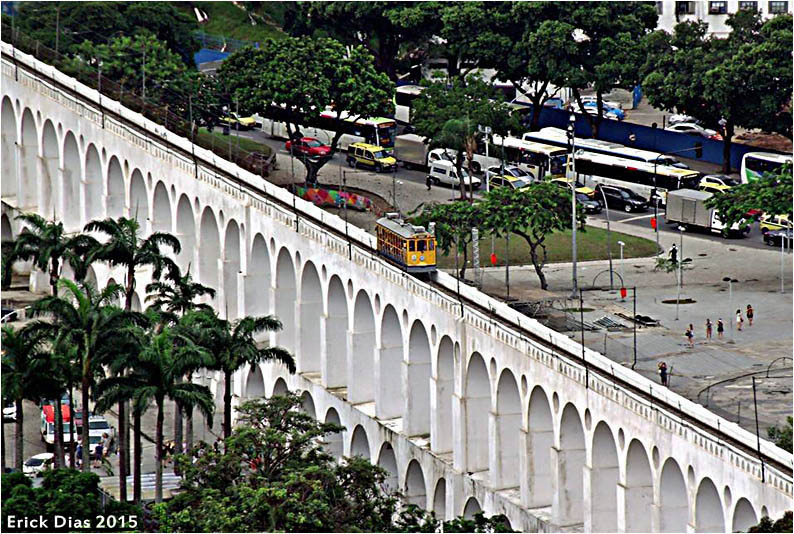
The
tramway has a tortured history. Landslides wiped out the Sumaré
line in 1912 and a hurricane closed the entire system in 1966 [see map].
Track to Paula Matos and Dois Irmãos was restored, but metro
construction in the 1970s shortened the downtown section. The system
reopened, but closed again after a serious accident in 2011 in which
six passengers died. A local builder, T'Trans, supplied 14 new trams,
the line was rebuilt and passengers rode free from Carioca to Curvelo for the first time in four years on 27 July 2015. This picture shows one of the new cars in August 2015 [Paulo Pacini]:
Operation continues uninterrupted on the private gasoline-powered monorail at the Vila Jardim Santa Cecília complex between Largo do França and Dois Irmãos. Rio de Janeiro's other surviving "tram" line is the 1000 mm gauge cog railway that climbs 670 m / 2,198 ft to the Christ statue overlooking Guanabara Bay. The Estrada de Ferro do Corcovado began operation with steam power in 1884 and was electrified in 1910 [AM]:
The latest innovation is Latin America's most ambitious light-rail project, known in Brazil as "Veículo Leve sobre Trilhos" (Light Vehicle on Rails) or "VLT". [English distinguishes Light Rail Vehicle – LRV – from Light Rail Transit – LRT, the line. But Brazilians use the term VLT for both.] Rio de Janeiro tried such a line, based on a Belgian "pre-metrô" model, in 1983. The articulated 2-car units were imported from Belgium:
It closed in 1985. Vehicles were rebuilt with third-rail shoes and the line became part of the city's metro system. A very different VLT – or LRV – project is underway today. After Rio was chosen to host the Olympic Games in 2016, plans began for a dense 28 km network of modern tram lines – almost entirely on paved streets – in the city center. A contract was signed with Alstom of France and construction began in 2013. The first 7-car unit arrived in June 2015, when the photograph below was taken. That's Mayor Eduardo Paes and family at the front [Rio Prefeitura]:
Campinas: LRV • Taquaral Despite the failure of Rio's (first) LRV line in 1985, this large city 90 km north of São Paulo built a similar light rail line in 1990 – also on the roadbed of a former steam railway. Its six articulated units were similar to those used in Rio [see above], but were built by Companhia Brasileira de Materiais Ferroviários [Cobrasma] in Brazil [AM]:
After two years of test runs, revenue service along the 8 km route finally began in April 1993. But the area that it served was lightly populated and the line did not reach the city center. A newspaper said that it "ligou nada a lugar nenhum" (connected nothing to no place). Ridership was low and the Campinas LRV line carried its last passenger in February 1995. The vehicles were scrapped. However, Campinas is not without a tram line today. Its original tramway system ceased operation in 1968, but the municipality salvaged several cars and built a new line for them around a lake in Parque Taquaral on the north side of town [see map]. Operation began on 5 November 1972 and four open Brill-type trams have been carrying passengers on the 3 km line every Saturday and Sunday ever since [AM]:
The park was renamed Parque Portugal in 1980, but most residents (and taxi drivers: take note) still call it Parque Taquaral. The line, which is municipally owned and operated, celebrated its 43rd birthday in 2015. It is the oldest heritage tramway in Latin America and one of the oldest in the world. Part 2 of my Campinas site has more information and 14 illustrations. YouTube videos are surprisingly scarce: this one shows a tram arriving at a station, but not much else. For discussion and pictures of the Campinas VLT, which ran from 1991 to 1995, see my pages on Light Rail in Brazil. Santos: Bonde Turístico • LRV The Tramways of Santos ceased operation on 28 February 1971. It was the last closure of a big-city tramway system in Brazil, leaving only the Santa Teresa lines in Rio de Janeiro. In 1984 the Santos mayor dug up 900 meters of disused track along Embaré Beach, restrung wire and placed restored tram 46 back in service. But the line was isolated, maintenance was difficult and the service lasted only two years. Fourteen years later, a new administration resuscitated 1.7 km of track in the old commercial, port area of Santos, hung wire again and put open tram 32 back in operation on 23 September 2000 [see map]. A trailer was added soon after [Marcelo Madariaga]:
The city's new Bonde Turístico was a tremendous success, with both residents and visitors. A second motor car, closed tram 40, also from the city's original fleet, was added in 2002 [Antonio Gorni]:
In 2006 Santos imported three Brill-type trams from the system in Porto, Portugal. Their track gauge had to be adjusted from the "standard" 1435 mm used in Porto to the unique 1350 mm gauge used in Santos, and shown below [João Manuel Picado]:
The vehicles shown above are all 2-axle models. In 2009 Santos imported two larger cars from the tramway system in Torino, Italy: 4-axle tram 3265 and 6-axle articulated tram 2840. Car 3265, built in Italy in 1950, was transformed into the Bonde Café, where passengers can enjoy light meals and (of course) coffee as they tour the line. The Bonde Café entered service on 9 January 2015 [Mexido de idéias]:
Ex-Torino 2840 is being rebuilt as a restaurant car. Santos has also acquired 4-axle tram 206 from Nagasaki, Japan, and a tram from São Paulo which once ran on Broadway in New York. The tram line was lengthened twice in 2009 and is now 4.9 km long [see map]. Torino car 3265 began carrying passengers in September 2010, when the tramway celebrated its 10th anniversary. Present operation is Tuesday-Saturday 11-5. See 27 videos of Santos trams (!) by Emílio Pechini. Perhaps to commemorate the 1983 LRV line in Rio de Janeiro and the 1993 LRV line in Campinas, Santos began construction of a LRV line in 2013 – which, like those earlier lines, would use the right-or-way of a former railway. The Empresa Metropolitana de Transportes Urbanos (EMTU) of São Paulo state ordered three LRVs from Vossloh in Spain and began offering free rides over the São Vicente segment of the line in April 2015. The line was extended to Santos in June [see map and article]:
Nineteen
other identical LRVs are being supplied by T'Trans in Três Rios,
Brazil – the same company that built the new Santa Teresa cars.
See Santos VLT - Bonde - Trólebus. The Itatinga Hydroelectric Plant is located in a cove at the base of the Serra do Mar, 8 km north of Bertioga, a beach town on the Atlantic Ocean 35 km east of Santos. Electricity from the Itatinga Dam, 900 m above, powers the railroads, derricks and docks of the port. To build the plant in 1906, the Companhia Docas de Santos built an 800 mm gauge railroad and a dock on the Itapanhaú River across from Bertioga [see map]. A few houses, a grocery store, church and cinema sprung up around the usina (plant). But there were no roads or automobiles. CDS constructed two tramcars and electrified the railway in January 1958. Here is car number 1 in Itatinga village [col. AM]:
The two trams still ply the 7-km line today and provide the only transportation between Itatinga and the outside world. Unfortunately, in recent years a small gasoline-powered tractor has been used to pull the cars in normal service. The trams run electrically only when it rains! See CODESP: Itatinga. Also see A Trip to Itatinga, a 9-minute silent film made in 1980. Here's another film which lasts 10 minutes. This one shows the gasoline operation. Also see the photograph collection of Antonio Gorni. Campos do Jordão The Estrada de Ferro Campos do Jordão opened as a steam railroad in 1914 and was electrified in 1924. The 47-km meter-gauge line connects the Pindamonhangaba station of the Rio de Janeiro - São Paulo railroad with Campos do Jordão, a semi-resort area atop a mountain, a sort of Brazilian Aspen [see map]. At km 37 the line reaches an altitude of 1,743 m / 5,660 ft, the highest of any railway in Brazil. The original electric fleet consisted of four cars from Midland Railway, Carriage & Wagon Co. in England. Single-end car A-4 below, photographed in a residential area near Jaguaribe, was constructed in 1932 in Brazil [AM]:
In 1956 the company acquired three electric trams from the abandoned Guarujá tramway near Santos, to provide local service along the urban section of the line, between São Cristóvão and Emílio Ribas [see map]. This photograph shows one of the German cars, built by Maschinenfabrik Augsburg-Nürnberg in 1924, near Abernéssia [AM]:
In
recent years Campos do Jordão has become a popular destination
for weekenders from São Paulo and EFCJ rides up the mountain are
booked far in advance. See the company's official website. Also see my EFCJ website which contains history, description, map and 40 photographs. See also the EFCJ webpages of Ralph Giesbrecht and Antonio Gorni, which in turn have links to other pages. YouTube offers numerous short videos, including (1), (2) and (3).. Cuiabá This city of a half million is said to be in the geographical center of South America. It is one of Brazil's most remote large cities and was never connected by railroad with other cities. After the announcement in 2007 that Cuiabá would be one of 12 Brazilian cities that would host the World Cup football games in 2014, it began plans to improve its local transportation. A contract to build a light rail system was signed in 2012 with a consortium of CR Almeida and Santa Bárbara Construções of Brazil. Forty 7-module LRVs were ordered from CAF in Spain. They began arriving in 2013 when the photograph below was taken [col. AM]:
Like the new tramway under construction in Rio de Janeiro, the Cuiabá project is especially costly for it is completely new and, unlike the Santos line, not built on the path of a former railroad. Cuiabá never had any railroads. It also involves numerous viaducts and a long bridge over Rio Cuiabá. Federal funds ran out and construction of the line halted in 2014. The line lay dormant for all of 2015. Work is supposed to resume in early 2016. See Cuiabá: from tram to LRV. Cassino According to the Guinness Book of Records, this seaside town near Rio Grande, Brazil's southernmost city, has the world's longest beach: 254 km [see map 1]. Cassino is also famous for its vagonetas a vela (sail-powered cars) that travel along the rails of the molhes da barra (breakwaters) which go far out to sea [see map 2]. The little cars are a long way from the light rail vehicles shown above, but they might still be considered trams of a sort: they are resourceful and very, very "green" [postcard, col. AM]:
Take a ride on this short video. Or an airplane ride over the beach. For more information and another postcard view, see The Tramways of Rio Grande. Brazil's intercity rail lines between Rio de Janeiro and São Paulo, between Rio de Janeiro and Belo Horizonte, and from Santos through São Paulo to Campinas and beyond were built to 1600 mm / 63 in track gauge. This is also the gauge today of the metros in Rio de Janeiro, São Paulo, Recife, et al. But all its new VLT lines use 1435 mm / 56.5 in gauge. Almost all other railways in Brazil, from the Amazon River south to the Uruguayan border, thousands of kilometers of them, have 1000 mm / 39.4 in gauge tracks. Brazil has the world's largest meter-gauge railway network. With the decline of rail travel at the end of the last century, many of these rails became obsolete – until a company named Bom Sinal Indústria e Comércio in Ceará state decided to recycle the tracks around cities. Bom Sinal ("Good Sign"), founded in 1999, remodeled passenger trains for the metro company in Fortaleza, the Ceará capital. Using hydraulic "railpacks" supplied by Voith of Germany, Bom Sinal built three articulated, air conditioned, diesel-powered LRVs for operation on meter-gauge track. Two of them began providing free rides for passengers in December 2009 over a 14 km line between Crato and Juazeiro do Norte, two small towns in the Cariri district of southern Ceará. The route has twelve stations. "Metro do Cariri" started revenue service in May 2010 [see map]. The pictures below were taken the following August [Marcelo Almirante]:
The vehicles were said to be the first LRVs constructed in Brazil [if one excludes the six that Cobrasma built in 1990 for Campinas; see above]. Each 2-car Bom Sinal LRV carries 330 passengers (seated and standing) [Marcelo Almirante]:
Here is a Cariri video – with links to other videos. The Cariri line inspired similar projects in northeastern Brazil – all involving Bom Sinal LRVs on meter-gauge track. The following image, extracted from a video, shows Goiabeira station on the 32 km line that opened in 2011 in Maceió, capital of Alagoas state [see map; see video] [solemar Paraíso das Águas]:
The eight LRVs of the Maceió line carried 2,675,184 passengers in 2014. The vehicle in the next picture is identical, but is operating on the 56 km system in Natal, capital of Rio Grande do Norte state [see map]. [Is it on fire? Is that smoke or a photo defect?] Both the Maceió and Natal lines are operated by the Companhia Brasileira de Trens Urbanos:
The Natal system has two routes [see map]. The LRV shown below is headed south to Parnamirim. Some Natal motorists are no doubt unhappy with what has happened to their streets:
A rural section of Natal's northern line [see map]:
Most of the routes of the metro systems in Fortaleza, Ceará's capital, and Recife, capital of Pernambuco state, are operated electrically. But each system also has a line operated with diesel LRVs constructed by Bom Sinal. Here is the Cajueiro Seco station of the Recife metro, junction of a 1000 mm gauge diesel line on the left and the 1600 mm gauge electric line on the right. This Bom Sinal LRV will travel 18.5 km south to Cabo [see map] [Paulo Magalhães]:
Call them metros or light rail or suburban railways or tramways or whatever – all these diesel lines use the same tram-like vehicles that run on existing meter-gauge track. A notable exception is the street railway system that opened in 2014 in Sobral, a city of 200,000 in northern Ceará. Its Bom Sinal cars all run on newly laid track on city streets [col. AM]:
This animated video includes a map and describes the innovative Sobral system better than any photographs that could be found. Bom Sinal recently explored a partnership with another German firm, Vossloh, in order to build an electric LRV. Vossloh even considered purchasing the Brazilian company. But there has been no further news of this plan. _____________
ARGENTINA An article in the 17 May 1872 edition of the English journal Engineering called the Argentine capital "The City of Tramways" because, it believed, it had more miles of street railway per capita than any other city in the world. Tramway development continued unabated for the next half century. Fifteen different companies inaugurated electric tram lines between 1897 and 1922! One of the extraordinary innovations of this period was a 4-door tram model for use on the city's first metro line, which opened in 1913. Tranvía subterráneo S51, built by La Brugeoise, Nicaise et Delcuve in Belgium, had both high-level doors in the center for loading from platforms in the underground section and ordinary tramway steps at both ends for use when the car ran on the street. The definitive "subway-surface" tram? Was it a prototype LRV?
Inspired by its success of these AAT enterprises, the rapid transit company constructed a completely new tram line in 1986. Premetro route "E2" is a 7.4 km surface extension of subte line "E", from its terminus at Plaza de los Virreyes to Barrio General Savio [see map]. Revenue service was inaugurated in 1987 with eight rebuilt subte cars, which were replaced the following year by 17 completely new trams built by Materfer, a railway equipment manufacturer in Córdoba. The photo below shows Materfer tram PM8 at General Savio terminus [Ralph Forty]:
That was only the beginning. In 1995, a new company called Sociedad Comercial del Plata built a 15.5 km light rail line along the roadbed of a suburban railway that closed in 1961 ['1' on the map]. Track gauge of the Tren de la Costa, as of the Tramway Histórico and E2 lines, is standard 1435 mm, but its nine articulated units built by CAF in Spain operate left-hand, English style. Number 2 approaches in this view [M. Cáceres Miranda]:
There's more! In 2006 the rail operator Ferrovías built a 16-block "demonstration" tramway called Tranvía del Este along a disused freight line in the Puerto Madero district, just east of the city center ['TE' on the map]. The French manufacturer Alstom sent two of its multi-section trams, on loan, from the tramway system in Mulhouse, France, and the Puerto Madero Tramway began operation on Bastille Day, 14 July 2007. The Mulhouse cars returned to France in 2008 and a similar tram was purchased from Metro de Madrid. But the line ran basically "from nowhere to no place" and did not carry many passengers. Operation ceased on 10 October 2012 and the fates of the tramway and the tramcar are unknown. This picture was taken in 2008 [Bruce Russell]:
Aquilino González Podestá, president of the Asociación Amigos del Tranvía, has posted a detailed Historia del Tranvía en Buenos Aires. The Córdoba tramway amigos present a general history of the Tranvías Argentinos, which considers all cities including Buenos Aires. There are Wikipedia pages and photo surveys of all the lines. A chapter entitled Tren CAF describes the vehicles that Construcciones y Auxiliar de Ferrocarriles built for the Tren de la Costa. There is a forum on the Tranvía del Este (Puerto Madero) and there are numerous YouTube videos of the Tramway Histórico including (1), (2), (3) and (4); Premetro line E2 at (1); Tren de la Costa at (1); and Tranvía del Este at (1) and (2). New videos are added frequently.
The large Belgian-built tramway system in this city, located about 240 km/150 mi northwest of Buenos Aires, closed in 1963. In 1981 members of the Asociación Rosarina Amigos del Riel (A.R.A.R.) enthusiast group located tram 277, one of three experimental models built by the tramway company in 1938-1939, sitting on the shore of the Paraná River. It had been used for years as a shelter for fishermen. Over the next three decades the car was rebuilt, with a truck from a fan group in Montevideo and motors and other equipment from the Tervuren Museum in Brussels. The local trolleybus company strung wire on Av. Wheelwright, where old tram rails remained. The photograph below shows the inauguration of the new service on 4 March 2015 [A.R.A.R.]: 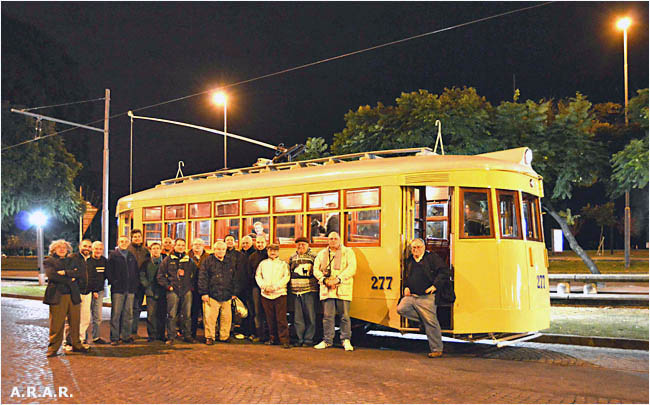 Mar del Plata The original tramway system in this Argentine seaside resort, 400 km south of Buenos Aires, closed in 1954. In 1995 a local radio announcer and a group of tramway enthusiasts laid 1.5 km of track along a coastal highway and imported two 4-axle trams from Lisboa, Portugal: number 342 built by J. G. Brill in 1906 and number 343 built by John Stephenson in 1907. Operation began at Christmas 1997 and the line was extended 4 km to Parque Camet, farther up the coast, in 1999 [see map]. A tram garage and a 3 km circuit were built inside the park, the coastal line closed, and the two cars began running in the park in 2000. Operation has been intermittent since that time, but the line was recently reconstructed and extended. The photograph shows Brill tram 342 in 2000 [Aquilino González Podestá]: |
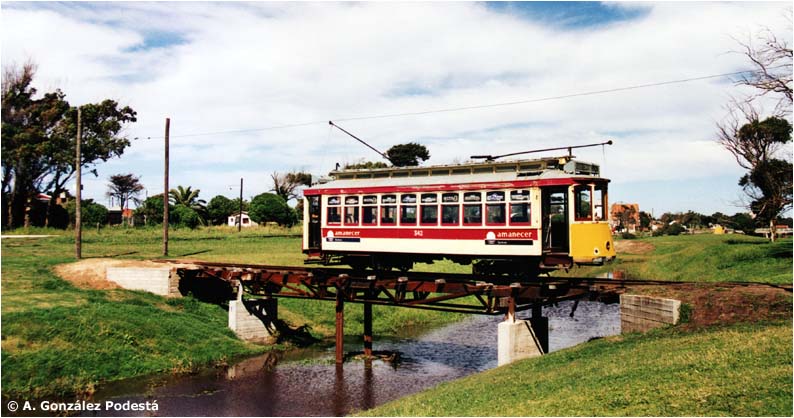
The Parque Camet tramway currently operates 12-7 daily January-February and 12-5 weekends March-December. See more pictures on my Mar del Plata page. A travel agent describes the tramway and its schedule. A 2009 article about the park's Museo de las Comunicaciones erroneously states that the trams are from Porto (they are from Lisboa; it is Buenos Aires that has trams from Porto). Here are some curious architectural drawings. No movies of the Parque Camet tramway could be found.
Valle Hermoso"Beautiful Valley" is a small town 65 km northwest of Córdoba, Argentina, which is 750 km northwest of Buenos Aires. In the 1990s a local resident, Prof. Osvaldo Pedro Ferreiro, built a tram car and a 600 mm gauge tram line around the grounds of his property, which includes the town's former railroad station. The car is numbered 652 in homage to tram 652 of the Tramway Histórico in Buenos Aires [see above]. The enterprise is called "Paseo Con Ciencia" (Science Excursion) because it encompasses various scientific, botanical and environmental exhibits, including a planetarium, which he and his family created. The line and the displays were inaugurated on 6 March 1998 and have been open to the public year round ever since [Jack May]:
See my page on The Very Special Electric Tramway in
Valle Hermoso. A page entitled Un Tranvía llamado Botánico presents a nice slide show and another called Paseo Con Ciencia describes the project. This video shows a ride on the line.
Mendoza
The capital of Argentina's wine country, on the edge of the Andes about 1,000 km from Buenos Aires, has a metropolitan population of about a million. After the last passenger train left for Buenos Aires in 1992, the city started plans to lay a light rail line in the urban section of its path [see map]. The old 1676 mm and 1000 mm gauge tracks were replaced by new 1435 mm gauge tracks and 11 LRVs were purchased in 2010 from the Metropolitan Transit System in San Diego, U.S.A. The vehicles had been built by Siemens Düwag in Germany in the 1980s, but were still in very good condition. More vehicles arrived in 2011 and revenue service over the 13.5 km line finally began on 8 October 2012 – exactly 100 years and 7 days after the city's original electric tramway, which also used Siemens equipment, was inaugurated in 1912. The following photograph, which shows the signals of the former steam line that were kept as a souvenir, was taken in September 2014 [Miguel Soulas]:
The "Metrotranvía" in Mendoza was one of Latin America's first light rail lines of the 21st century – preceded only by the diesel-powered lines in Brazil [see above]. Mendoza car 1005, below, was headed east toward Maipú in July 2013 [see map]. The Andes see snow year round and sometimes it falls in Mendoza ["Me Gusta Mendoza"]:
In 2015, the line was being extended 5.5 km north to Panquehua, near Mendoza International Airport. See Mendoza: Trams, Trolleybuses, Metrotranvía.
Also see my index of
ELECTRIC TRANSPORT IN LATIN AMERICAThis page was placed online in November 2010 and extensively revised in December 2015
Copyright © 2010-2110 Allen Morrison
ALL RIGHTS RESERVED
TODOS OS DIREITOS RESERVADOS
TODOS LOS DERECHOS RESERVADOS
